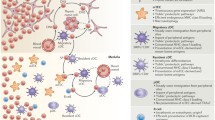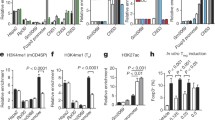Abstract
Autologous proteins are continuously processed and presented in the form of peptides associated with self major histocompatibility (MHC) molecules at the surface of antigen-presenting cells for interaction with autoreactive T cells. During thymic selection, the presentation of self peptides is an essential element in the establishment of the T cell repertoire. Developing T cells which recognize self peptide/self MHC complexes with sufficient affinity are clonally deleted. However, we and others have recently demonstrated that a variety of self peptides, despite their high binding affinity to MHC molecules, never reach the threshold of presentation to ensure negative selection (cryptic self peptides). This mechanism may have been selected to avoid excessive purging of T cell repertoire during ontogeny. However, T cells directed to cryptic self determinants represent a continuous threat for the initiation of autoimmunity in adults. Supporting this view, recent studies have documented the involvement of cryptic self peptide presentation in different autoimmune diseases. In this article, we examine the factors that govern the selection of self peptides for presentation to autoreactive T cells in vivo and discuss their contribution to both the induction and the maintenance of self tolerance. In addition, we analyze the mechanisms by which the hierarchy of determinants on a self protein can be disrupted, thereby leading to the presentation of previously cryptic self peptides and the induction of an autoimmune T-cell-mediated process.
Similar content being viewed by others
References
Townsend ARM, Rothbard J, Gotch FM, Bamadur G, Wraith D, McMichael AJ: The epitepes of influenza nucleoprotein recognized by cytotoxic T lymphocytes can be defined with short synthetic peptides. Cell 1986;44:959–968.
Babbit BP, Allen PM, Matsueda G, Haber EP, Unanue ER: Binding of immunogenic peptides to a Ia histocompatibility molecule. Nature 1985;317:359–361.
Kappler JW, Staerz UD, White J, Marrack PC: Self-tolerance eliminates T cells specific for Mls-modified products of the major histocompatibility complex. Nature 1988;322:35–40.
Kisielow P, Bluthmann H, Staerz UD, Steinmetz M, von Boehmer H: Tolerance in T cell receptor transgenic mice involves deletion of immature CD4+8+ thymocytes. Nature 1988;333:742–746
Kourilsky PJ, Chaouat G, Rabourdin-Combe C, Claverie J: Working principles in the immune system implied by the ‘peptidic self’ model. Proc Natl Acad Sci USA 1987;84:3400–3404.
Lorenz RG, Allen PM: Direct evidence for functional self-proteins/Ia complexes in vivo. Proc Natl Acad Sci USA 1988;85:5220–5223.
De Koster HS, Anderson DE, Termitjelen A: T cells sensitized to synthetic HLA-DR3 peptide give evidence of continuous presentation of denatured HLA-DR3 molecules by HLA-DP. J Exp Med 1989;169:1191–1196.
Rotzschke O, Falk K, Deres K, Schild H, Norda M, Metzger J, Jung G, Rammensee HG: Isolation and analysis of naturally processed viral peptides as recognized by cytotoxic T cells. Nature 1990;348:252–254.
Rudensky AY, Preston HP, Hong SC, Barlow A, Janeway CJ: Sequence analysis of peptides bound to MHC class II molecules. Nature 1991;353:622–627.
Nikolic-Zugic J, Bevan MJ: Role of self-peptides in positively selecting the T-cell repertoire. Nature 1990; 344:65–67.
Gammon G, Cogswell J, Wilbur S, Sadegh-Nasseri S, Krzych U, Miller A, Sercarz E: The choice of T-cell epitopes utilized on a protein antigen depends on multiple factors distant from, as well as the determinant site. Immunol Rev 1987;98:53–73.
Gammon G, Sercarz EE: How some T-cells escape tolerance induction. Nature 1989;342:183–185.
Schild H, Rotzschke O, Kalbacher H, Rammensee H: Limit of T cell tolerance to self proteins by peptide presentation. Science 1990;247:1587–1589.
Benichou G, Takizawa PA, Ho PT, Killion CC, Olson CA, McMillan M, Sercarz EE: Immunogenicity and tolerogenicity of self-major histocompatibility complex peptides. J Exp Med 1990;172:1341–1346.
Gammon G, Sercarz EE, Benichou G: The specificity of the autoreactive T cell repertoire: The dominant self and the cryptic self. Immunol Today 1991;12:193–195.
Cibotti R, Kanellopoulos J, Cabaniols JP, Halle-Panenko O, Kosmatopoulos K, Sercarz EE, Kourilsky P: Tolerance to a self-protein involves its immunodominant but not subdominant determinants. Proc Natl Acad Sci USA 1992;89:416–420.
Lipham WJ, Redmond TM, Takahashi H, Berzofsky JA, Wiggert B, Chader GJ, Gery I: Recognition of peptides that are immunopathogenic but cryptic. Mechanisms that allow lymphocytes sensitized against cryptic peptides to initiate pathogenic autoimmune processes. J Immunol 1991;146:3757–1963.
Benichou G, Fedoseyeva E, Olson CA, Geysen HM, McMillan M, Sercarz EE: Disruption of the determinant hierarchy on a self-MHC peptide: Concomitant tolerance induction to the domaint determinant and priming to the cryptic self-determinant. Int Immunol 1994;6:131–138.
Lehmann PV, Forsthuber T, Miller A, Sercarz EE: Spreading of T cell autoimmunity to cryptic determinants of an autoantigen. Nature 1992;358:155–157.
Simitsek PD, Campbell DG, Lanzavecchia A, Fairweather N, Watts C: Modulation of antigen processing by bound antibodies can boost or suppress class II major histocompatibility complex presentation of different T cell determinants. J Exp Med 1995;181:1957–1963.
Salemi S, Caporossi AP, Boffa L, Longobardi MG, Barnaba V: HIV gp120 activates autoreactive CD4-specific T cell responses by unveiling CD4 peptides during processing. J Exp Med 1995;181:2253–2257.
Sercarz EE, Lehmann PV, Ametani A, Benichou G, Milier A, Moudgil K: Dominance and crypticity of T cell antigenic determinants. Annu Rev Immunol 1993;11:729–766.
Brown MG, Driscoll J, Monaco JJ: Structural and serological similarity of MHC-linked LMP and proteasome (multicatalytic proteinase) complexes. Nature 1991;353:355–357.
Glynne R, Powis SH, Beck S, Keely A, Kerr A, Kerr L, Trowsdale J: A proteosome-related gene between the two ABC transporter loci in the class II region of the human MHC. Nature 1991;353:357–360.
Monaco JJ, Cho S, Attaya M: Transport protein genes in the murine MHC: Possible implications for antigen processing. Science 1990;250:1723–1726.
Deverson EV, Gow JR, Coadwell WJ, Monaco JJ, Butcher GW, Howard JC: MHC class II region encoding proteins related to the multidrug resistance family of transmembrane transporters. Nature 1990;348:738–744.
Spies T, Breshnahan M, Bahram S, Arnold D, Blanck G, Mellins E, Pious D, DeMars R: A gene in the human major histocompatibility complex class II region controlling the class I antigen processing pathway. Nature 1990;348:744–747.
Bodmer H, Viville S, Benoist C, Mathis D: Diversity of endogenous epitopes bound to MHC class II molecules limited by invariant chain. Science 1994;263:1284–1286.
Vanbuskirk A, Crump BL, Margoliash E, Pierce SK: A peptide binding protein having a role in antigen presentation is a member of the hsp70 heat shock family. J Exp Med 1989; 170:1799–1809.
Fling SP, Arp B, Pious D: HLA-DMA and-DMB genes are both required for MHC class II/peptide complex formation in antigen-presenting cells. Nature 1994;368:554–558.
Morris P, Shaman J, Attaya M, Amaya M, Goodman S, Bergman C, Monaco JJ, Mellins E: An essential role for HLA-DM in antigen presentation by class II major histocompatibility molecules. Nature 1994;368:551–554.
Nuchtern JG, Biddison WE, Klausner RD: Class II MHC molecules can use the endogenous pathway of antigen presentation. Nature 1990;343:74–76.
Weiss S, Bogen B: MHC class II-restricted presentation of intracellular antigen. Cell 1991;64:767–776.
Loss GE, Elias CG, Fields PE, Ribaudo RK, McKisic M, Sant AJ: Major histocompatibility complex class II restricted presentation of an internally synthesized antigen displays cell-type variability and segregates from the exogenous class II and endogenous class I presentation pathways. J Exp Med 1993;178:73–85.
Fedoseyeva EV, Tam RT, Orr PL, Garovey MR, Benichou G: Presentation of a self-peptide for in vivo tolerance induction of CD4+ T cells is governed by a processing factor which maps to the class II region of the major histocompatibility complex locus. J Exp Med 1995;182:1481–1491.
Martin R, McFarland HF, McFarlin DE: Immunological aspects of demyelinating diseases Annu Rev Immunol 1992;10:153–187.
McRae BL, Vanderlugt CL, Dal Canto MC, Miller SD: Functional evidence for epitope spreading in the relapsing pathology of experimental autoimmune encephalomyelitis. J Exp Med 1995;182:75–85.
Oldstone MBA: Molecular mimicry and autoimmune disease. Cell 1987; 50:819–820.
Nickerson C, Luthra CH, David C: Antigenic mimicry and autoimmune diseases. Int Rev Immunol 1991;7:205–224.
Luo A, Garza KM, Hunt D, Tung KSK: Antigen mimicry in autoimmune disease. Sharing of amino acid residues critical for pathogenic T cell activation. J Clin. Invest 1993; 92:2117–2123.
Singh VK, Kalra HK, Yamaki K, Abe T, Donoso LA, Shinohara T: Morecular mimicry between a uveopathogenic site of S-antigen and viral peptides. Induction of experimental autoimmune uveitis in Lewis rats. J Immunol 1990;144:1282–1287.
Hagerty DT, Allen PM: Intramolecular mimicry. Identification and analysis of two cross-reactive T cell epitopes within a single protein. J Immunol 1995;155:2993–3001.
Tam RC, Fedoseyeva EV, Moskalenko M, Garovoy MR, Benichou G: T cell tolerance is influenced by concomitant recognition of crossreactive self-peptides. J Immunol 1996; 156:3765–3771.
Cerasoli DM, McGrath J, Carding SR, Shih FF, Knowles BB, Caton AJ: Low avidity recognition of a class II-restricted neo-self peptide by virus-specific T cells. Int Immunol 1995;7:935–945.
Moudgil KD, Sercarz EE: Dominant determinants in hen eggwhite lysozyme correspond to the cryptic determinants within its self-homologue, mouse lysozyme: Implications in shaping the T cell repertoire and autoimmunity. J Exp Med 1993;178:2131–2138.
Bhardwaj V, Kumar V, Geysen HM, Sercarz EE: Degenerate recognition of a dissimilar antigenic peptide by myelin basic protein-reactive T cells. J Immunol 1993;151:5000–5010.
Author information
Authors and Affiliations
Rights and permissions
About this article
Cite this article
Benichou, G., Tam, R.C., Orr, P.I. et al. Self determinant selection and acquisition of the autoimmune T cell repertoire. Immunol Res 15, 234–245 (1996). https://doi.org/10.1007/BF02918251
Issue Date:
DOI: https://doi.org/10.1007/BF02918251




